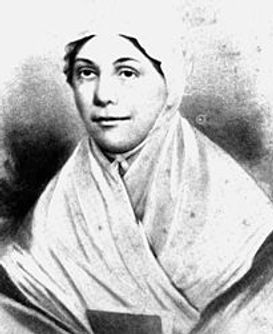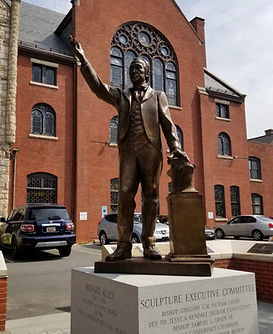The African Methodist
Episcopal Church
Our History
The AMEC grew out of the Free African Society (FAS) which Richard Allen, Absalom Jones, and others established in Philadelphia in 1787. When officials at St. George’s MEC pulled blacks off their knees while praying, FAS members discovered just how far American Methodists would go to enforce racial discrimination against African Americans. Hence, these members of St. George’s made plans to transform their mutual aid society into an African congregation. Although most wanted to affiliate with the Protestant Episcopal Church, Allen led a small group who resolved to remain Methodists. In 1794 Bethel AME was dedicated with Allen as pastor. To establish Bethel’s independence from interfering white Methodists, Allen, a former Delaware slave, successfully sued in the Pennsylvania courts in 1807 and 1815 for the right of his congregation to exist as an independent institution. Because black Methodists in other middle Atlantic communities encountered racism and desired religious autonomy, Allen called them to meet in Philadelphia to form a new Wesleyan denomination, the AME.

The geographical spread of the AMEC prior to the Civil War was mainly restricted to the Northeast and Midwest. Major congregations were established in Philadelphia, New York, Boston, Pittsburgh, Baltimore, Washington, DC, Cincinnati, Chicago, Detroit, and other large Blacksmith’s Shop cities. Numerous northern communities also gained a substantial AME presence. Remarkably, the slave states of Maryland, Kentucky, Missouri, Louisiana, and, for a few years, South Carolina, became additional locations for AME congregations. The denomination reached the Pacific Coast in the early 1850’s with churches in Stockton, Sacramento, San Francisco, and other places in California. Moreover, Bishop Morris Brown established the Canada Annual Conference.
The most significant era of denominational development occurred during the Civil War and Reconstruction. Oftentimes, with the permission of Union army officials AME clergy moved into the states of the collapsing Confederacy to pull newly freed slaves into their denomination. “I Seek My Brethren,” the title of an often repeated sermon that Theophilus G. Steward preached in South Carolina, became a clarion call to evangelize fellow blacks in Georgia, Florida, Alabama, Texas, and many other parts of the south. Hence, in 1880 AME membership reached 400,000 because of its rapid spread below the Mason-Dixon line. When Bishop Henry M. Turner pushed African Methodism across the Atlantic into Liberia and Sierra Leone in 1891 and into South Africa in 1896, the AME now laid claim to adherents on two continents.

While the AME is doctrinally Methodist, clergy, scholars, and lay persons have written important works which demonstrate the distinctive theology and praxis which have defined this Wesleyan body. Bishop Benjamin W. Arnett, in an address to the 1893 World’s Parliament of Religions, reminded the audience of the presence of blacks in the formation of Christianity. Bishop Benjamin T. Tanner wrote in 1895 in The Color of Solomon – What? that biblical scholars wrongly portrayed the son of David as a white man. In the post civil rights era theologians James H. Cone, Cecil W. Cone, and Jacqueline Grant who came out of the AME tradition critiqued Euro-centric Christianity and African American churches for their shortcomings in fully impacting the plight of those oppressed by racism, sexism, and economic disadvantage.
Today, the African Methodist Episcopal Church has membership in twenty Episcopal Districts in thirty-nine countries on five continents. The work of the Church is administered by twenty-one active bishops, and nine General Officers who manage the departments of the Church.
Our Motto
Bishop Daniel A. Payne proposed to the 1856 General Conference of the African Methodist Episcopal Church convening in Cincinnati, Ohio that the episcopal seal should include the denominational creedal statement, God Our Father, Christ Our Redeemer, Man Our Brother. This declaration of A.M.E. faith identity became the denominational motto until 1908, when a surge of pentecostalism in 1906 in Los Angeles at the Azusa Street mission, the former site of First A.M.E. Church, convinced African Methodists to alter the motto. Hence, the 1908 General Conference meeting in Norfolk, Virginia placed on the published minutes, God Our Father, Christ Our Redeemer, the Holy Ghost Our Comforter, Man Our Brother.
"God Our Father, Christ Our Redeemer, the Holy Spirit Our Comforter, Humankind Our Family."

The 1912 General Conference convening in Kansas City, Missouri retained the altered statement of A.M.E. belief. The centennial General Conference of 1916 meeting in Philadelphia, Pennsylvania, however, made no reference to new the A.M.E. motto, and since that time Bishop Payne’s original formulation of the motto appeared on all denominational documents and published materials.
At the 2008 General Conference in St. Louis, Missouri an inclusive motto was adopted and now declares God Our Father, Christ Our Redeemer, the Holy Spirit Our Comforter, Humankind Our Family. The evolution of our motto demonstrates that African Methodists engage in ongoing assessments of our theology and how God speaks to us in changing circumstances.
Dennis C. Dickerson | Retired General Officer
Our Mission
The Mission of the AME Church is to minister to the social, spiritual, and physical development of all people.
THE VISION
At every level of the Connection and in every local church, the AME Church shall engage in carrying out the spirit of the original Free African Society, out of which the AME Church evolved: that is, to seek out and save the lost, and to serve the needy. It is also the duty of the Church to continue to encourage all members to become involved in all aspects of church training.
THE PURPOSES
The ultimate purposes are:
-
make available God’s biblical principles,
-
spread Christ’s liberating gospel, and
-
provide continuing programs which will enhance the entire social development of all people.
THE OBJECTIVE
In order to meet the needs of every level of the Connection and in every local church, the AME Church shall implement strategies to train all members in: (1) Christian discipleship, (2) Christian leadership, (3) current teaching methods and materials, (4) the history and significance of the AME Church, (5) God’s biblical principles, and (6) social development to which all should be applied to daily living.
Our Bishops
The Bishops are the Chief Officers of the Connectional Organization. They are elected for life by a majority vote of the General Conference which meets every four years. Bishops shall be retired at that General Conference when the Bishop’s seventy-third (73rd) birthday is on or before July 15th of the General Conference Year.




